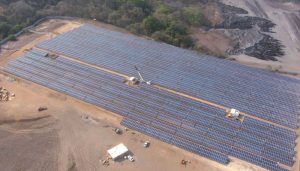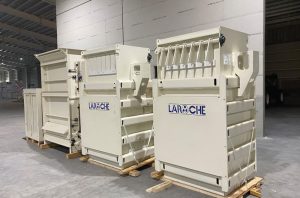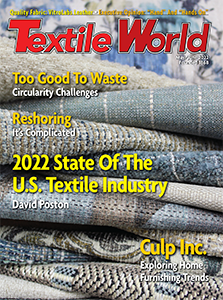
西方哼哼isphere textile industry continues to hear the promise of reshoring, but exploring the practical, rational and non-monetary implications is complicated.
吉姆·伯恩曼(Jim Borneman),总编辑
reshoring or near-shoring textile and apparel supply chains to the United States and Western Hemisphere really isn’t a new topic. For many years, Western Hemisphere groups have tried to make a case for sourcing close to where products will be sold. Even when exploring the total cost and speed-to-market issues, cost often worked against sourcing close to home and was maligned as protectionist as retailers and brands searched for the latest “cheap needle.”
Free Versus Fair Trade
过去,促进以西半球为重点的供应链经常转变为贸易法辩论,将西半球发起人标记为保护主义者,或公平交易者,以及全球源代理人作为全球主义者或自由交易者,他们希望让市场为自己说话。
For many years, these debates surfaced with every discussion of a new free-trade agreement (FTA), regional trade agreement — such as the Caribbean Basin Initiative (CBI), Caribbean Basin Trade Partnership Act (CBTPA), North American Free Trade Agreement (NAFTA), Dominican Republic-Central America Free Trade Agreement (CAFTA-DR) and United States–Mexico–Canada Agreement (USMCA) — and even the ascent of China into the World Trade Organization (WTO).
只有在向美国国防部(DOD)供应商品(国防部)的货物供应时,全球采购将导致供应链漏洞的显然情感上的论点。
浆果修正案的形成是要坚持认为,为美国军事人员提供的购买将由100%的美国制造产品组成,从而减少了国防部对外国供应链的依赖。
输入Covid-19:暴露的漏洞
当Covid-19在2020年大流行时,由于缺乏国内生产和制造一系列商品的制造,实际上并没有花很长时间才能看到美国人的暴露程度。
大多数人很少想到的事情现在是必不可少的项目 - N-95口罩和其他个人防护设备(PPE),用于测试,呼吸机和清单的拭子。
As consumers moved through the pandemic, supply chain disruptions came into focus with shipping issues, component shortages and lockdowns crippling labor and even threatening Christmas.
是时候进行新讨论
With the supply chain challenges top of mind, maybe it is worth considering a look at the promise of re- or near-shoring. With a focus on exploring the practical and rational implications at play and acknowledging the world has truly changed, the economics of trade need to be reimagined. Energy prices, shipping expenses, time-on-the-water — or the cost of speed-to-market — investment in downstream supply and infrastructure all are under examination.
The Rise Of Non-Monetary Social Costs
If phrases like traceability, circularity, forced labor, slave cotton, green manufacturing, sustainability, carbon footprint, fair labor practices are entering a sourcing decision-making-process, then factoring them into the re- or near-shoring calculation is essential. The challenge of considering non-monetary factors in a costing model has always been an issue of the product’s total cost — even valuing the cost effect of sustainability in a pre-COVID sourcing world or time-on-the-water as a cost of speed-to-market.
中美洲的投资正在发生
As previously reported by188BET金博宝下载, significant investments are occurring in Central America in support of near-shoring.
Miami-based Intradeco Holdings announced investments of more than $100 million in three major projects in Central America to make the most of CAFTA-DR and nearshoring opportunities, advance full circularity, and expand solar power. Its first project is the Central American Spinning Works, a state-of-the-art ring spinning mill in Honduras that began operations earlier this year. The second project is the creation of a manufacturing plant in El Salvador that uses 100-percent recycled yarns — both cotton and man-made fibers. A third project will allow the company to expand its solar energy power to attain 30 megawatts by the third quarter of 2022.

Intradeco董事长Felix Siman说:“我们的公告与我们40年的创新和服务一致,这与纺织品,服装和零售行业的组成部分相符。”“借助我们全面的分销渠道和最先进的供应链,我们可以在最短的时间内以有效且具有成本效益的方式吸引客户。Intradeco是巨大(美国洪都拉斯,危地马拉,萨尔瓦多)商业和投资委员会的创始成员。通过这些投资,我们公司正在帮助在中美洲创造1000多个工作岗位,同时为该地区的环境可持续发展目标做出贡献。”
Also reported recently by TW: “Gastonia, N.C.-headquartered Parkdale Mills, one of the largest manufacturers of spun yarn and cotton consumer products in the world, will make a multi-million-dollar investment in a new yarn spinning facility in Honduras and make an additional substantial investment to support existing operations in Hillsville, Va. This investment will help customers shift 1 million pounds of yarn per week away from supply chains in Asia and China and enhance U.S. and CAFTA-DR co-production resilience and increase regional product offerings. Parkdale’s announced investment will create hundreds of jobs in Honduras and further support hundreds of employees in Parkdale’s Hillsville operations.”
帕克代尔(Parkdale)董事长兼首席执行官安德森·沃利克(Anderson Warlick)指出:“帕克代尔(Parkdale)的投资将支持美国和中美洲地区的良好薪水工作,并大大提高我们广泛的产品和能力,包括生产可持续特色纱线。”
未来的贸易差异可能破坏努力
如前所述,似乎总是贸易活动to breed challenges and uncertainty to existing trade agreements. As consideration of nearshoring continues there is no doubt that the basic principles that underlie existing trade agreements will be reexamined and relitigated with all parties seeking an advantage. This can be destabilizing for those taking nearshoring and the investments necessary to perform at the highest levels and deliver a revitalized nearshoring supply chain seriously.
Look for the “yarn-forward” rule of the CAFTA-DR agreement to come under attack. Simply put, to ship a CAFTA-DR member country-made product into the United States duty free, it must be made from U.S.-made or indigenous yarn — yarn made in the CAFTA-DR member country of the product’s origin. This really disincentivizes importing Asian fabric — not made with U.S. or indigenous yarn — into CAFTA-DR countries to be made into garment for export to the United States because such products cannot enter duty free.
总部位于弗吉尼亚州赫恩登市的Werner International于2022年1月发布了一份报告,标题为“纱线前锋统治对Cafta-Dr签署者的经济和社会影响”。如果您在近岸供应链中的近乎文档或投资是您的业务策略的一部分,则该报告肯定值得阅读。
免税事项
Access to the U.S. market “duty free” is the reward for most trade agreement compliance. But for most in the industry, it simply means a price advantage compared to competing imports. The Werner International report provides some interesting benchmarking data that illustrates the effect of duties on landed duty paid U.S. prices of several garments made in China compared versus the same garments made by CAFTA-DR members in Honduras.
Werner比较了男士100%的棉质T恤,男士100%的聚酯活性T恤,男士五个口袋棉牛仔裤和纤维含量为96多利酯/4%Lycra(请参阅表1)。

According to the Werner evaluation, the “… table [located on page 17 of the report] shows the outcome in terms of the ex-factory price for each garment produced, the import duties paid into the U.S., and the final price, including duties paid, freight, and insurance costs.
“正如表所示,对美国市场的无义访问使CAFTA-DR国家在全球范围内在各种服装产品中对美国市场具有竞争力。与美国市场的强大,综合的共同制作链以及美国市场的固有优势是美国-CAFTA-DR贸易关系的固有优势。由于这种因素组合,该地区的定价具有竞争力。”
Werner goes on to state: “… China has a significant advantage in terms of raw material costs, particularly in synthetics. But the data also demonstrate that China’s pervasive price manipulation can be offset by the application of duty-free benefits for qualifying goods under the CAFTA-DR agreement.”
Keep in mind that China’s “price manipulation” is a longstanding point of contention between those identifying as free-traders versus fair-traders. But Werner also states that “[The] Central American polyester yarn industry has invested millions of dollars in the last two years and is projected to invest more in the next two to three years, which will improve the region’s competitiveness in regard to labor, energy, speed, and flexibility. These technology investments in polyester yarn production will yield significant cost improvements related to labor and energy and narrow the gap compared to China’s synthetic yarn costs.”
四个产品示例的职责范围从24%到39.5%,并将每种产品从更昂贵的洪都拉斯前提出的价格转移到较便宜的洪都拉斯降落税费的美国付费价格,这说明了CAFTA-DR合规性的权力。
承诺会保留吗?
Only the future performance of the on- and near-shoring supply chain participants, or co-producers, in relationships with top brands and retailers will tell if the the promise of textile reshoring is real and a part of the future. Significant challenges lie in valuing the benefits provided by the region and the economics of global trade being reimagined. There will be challenges to the yarn forward rule, which could impact other existing regional trade agreements. There is a lot at stake — investments, jobs and supply chain vulnerabilities all will play a role in the outcome.
May/June 2022




